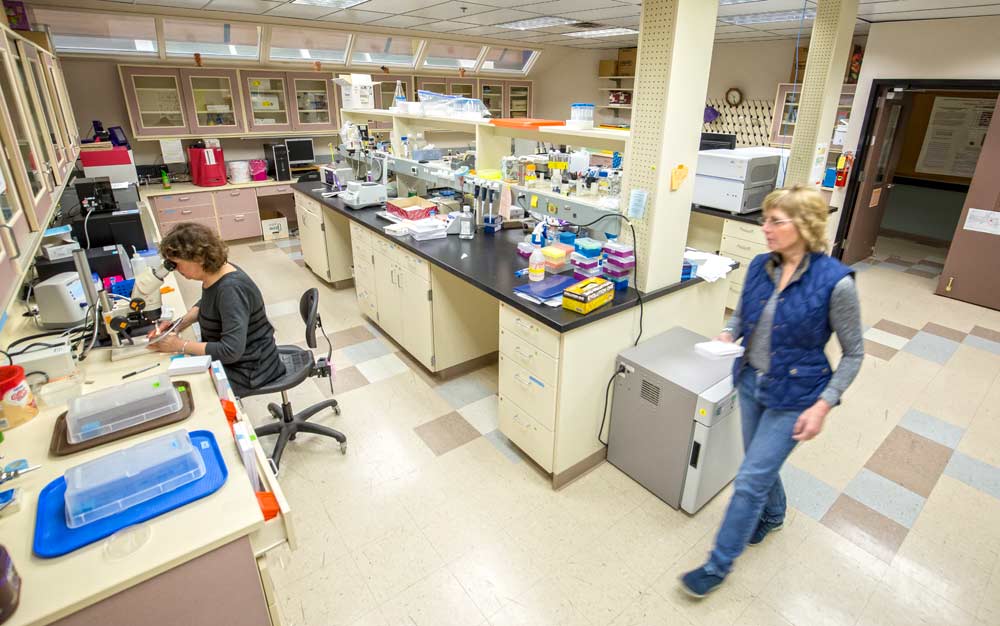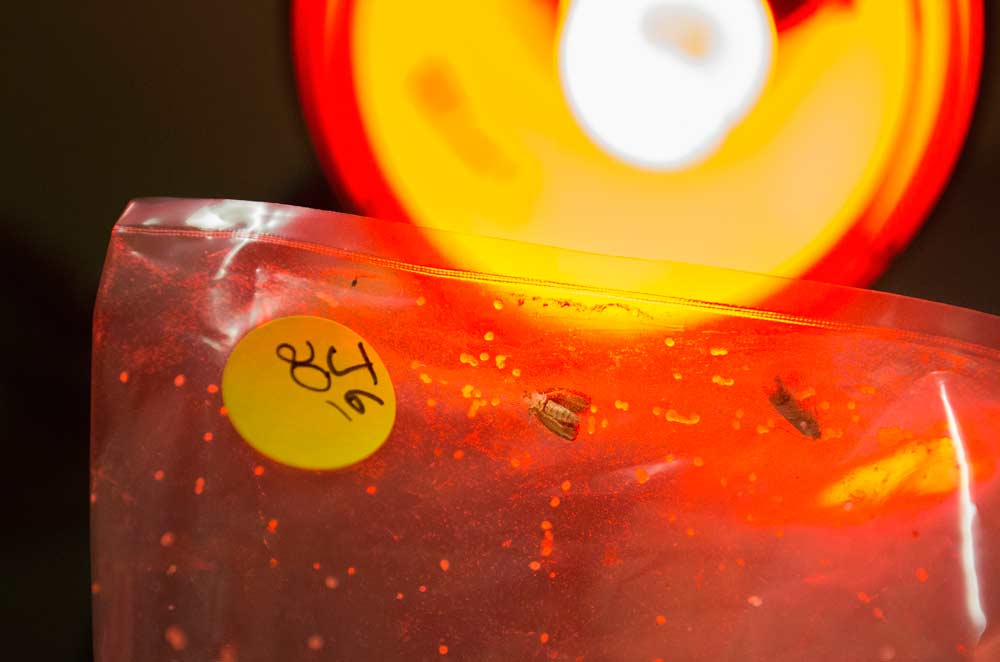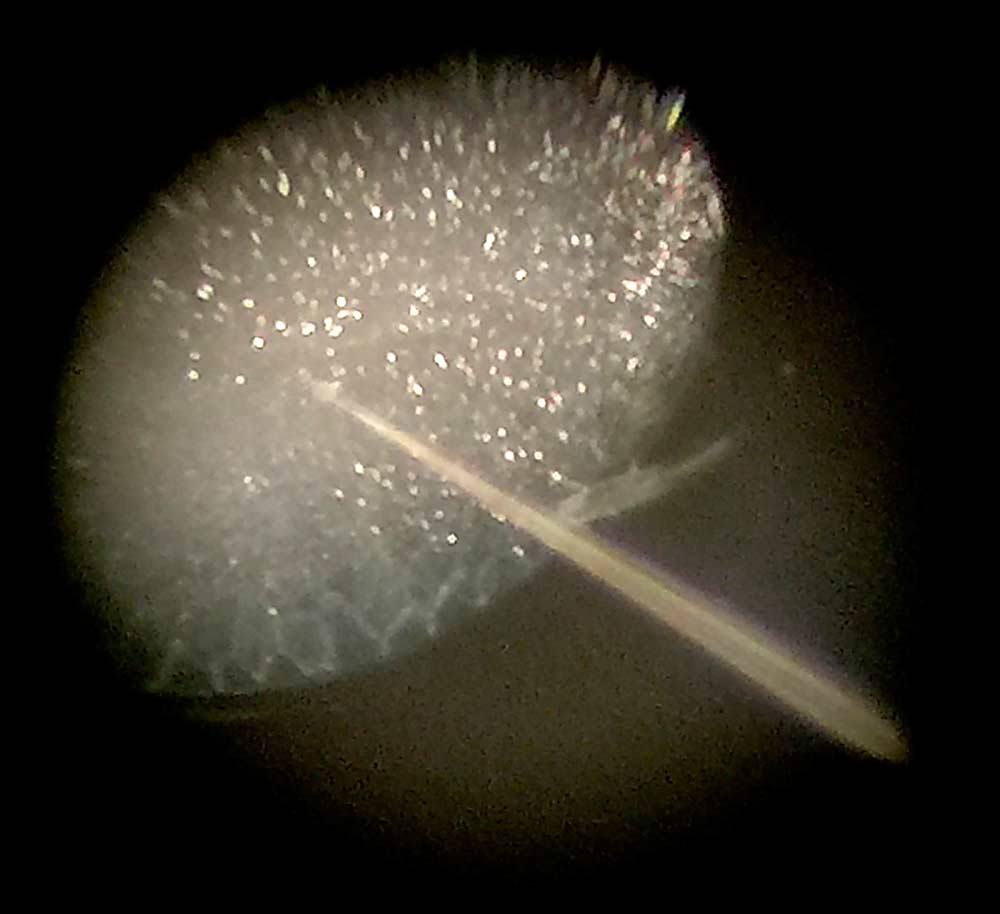
Kelly Archer, right, brings freshly laid codling moth eggs to Laura Willett, left, so Willett can inject a solution as part of a gene editing experiment at the USDA ARS lab in Wapato, Washington, in February. The cell walls surrounding the eggs become too hard for the procedure within minutes of being laid, forcing the team to work quickly and precisely.(TJ Mullinax/Good Fruit Grower)
Mutant codling moths are not headed to an orchard near you. But locked away in a Wapato, Washington, lab, mutant moths are giving scientists ideas about how to engineer a new era of target-specific pest controls.
Steve Garczynski, a geneticist with the U.S. Department of Agriculture’s Agricultural Research Service, has been tracking the genes that make a codling moth tick for years, but new gene-editing tools now allow him to put his theories to the test. By knocking out key genes, he’s figuring out what critical reproductive pathways could potentially be disrupted by chemicals acting like a species-specific birth control.
“I’m trying to find out how (the codling moth) works so I can figure out how to disrupt it,” Garczynski said.
He’s using a DNA editing tool known as CRISPR to create precise mutations in the moth genome. It’s the same tool that was used to create malaria-resistant mosquitos last year.
Around the country, researchers are using the same gene-editing tools to directly disable a variety of pests, as well as to engineer better crops and figure out how to correct human genetic disorders.
Garczynski’s first experiment focused on the gene he thinks controls the receptor for the moth’s mating pheromone, known as codlemone.
His theory was that knocking out the codlemone receptor would prevent males from finding females. But while his results on that front were lackluster — probably because several genes are involved — he stumbled onto a major finding.
“It turned out to be quite fortuitous, but we just took those edited moths and mated them and found that the females laid fewer eggs and none were viable,” Garczynski said. “It appears that when females produce codlemone to call for males, it also preps the eggs for fertilization, so when we knocked that out, the eggs don’t get prepared.”

Several codling moths hover near a red lamp in the USDA ARS facility’s codling moth warm eclosion (QC) room in Wapato, Washington. The moths are bred for testing purposes and kept in quarantine at the lab. (TJ Mullinax/Good Fruit Grower)
The mutation rendered the females effectively sterile. That sounds promising for pest control, but if the mutant moths can’t reproduce, they can’t pass on the altered gene and it won’t spread.
However, since it turns out that laying viable eggs is linked to pheromone signals, scientists should be able to design a pheromone-like chemical to interrupt the reproductive process.
“The applied avenue is like a codling moth birth control pill. Codling moth is the only moth with this receptor, so it would be very specific to codling moths,” Garczynski said. It’s not as far-fetched as it sounds. Research on chemicals that block pheromone receptors, thereby disrupting reproduction, are already being studied as controls for grain pests.
But Garczynski is just getting started. He has identified more than 100 genes he wants to knock out to figure out which moth mechanisms will best lend themselves to control techniques. Most are tied to blocking or interrupting reproduction, but not all.
“If we knock out a critical gene that controls the insect, it’s not going to survive. But if we can prevent the codling moth from finding the apple to lay eggs on, for example … it would greatly reduce the population and damage in the orchard,” he said.
Making mutants

minutes after it was laid, under a microscope to practice inserting a microinjection needle into the egg at the U.S. Department of Agriculture ARS facility in Wapato, Washington. Willett’s ability to precisely operate the needle tip allows for successful gene editing to the codling moth before it matures into larvae and, eventually, into an adult. Willett, a biological science technician with USDA, is part of Steve Garczynski’s team looking at ways to prevent codling moth from propagating by using the gene editing tool, CRISPR. (TJ Mullinax/Good Fruit Grower)
After identifying a target gene of interest, Garczynski makes a piece of single-stranded RNA that matches the double-stranded DNA.
In the CRISPR gene editing system, this is known as the guide RNA, because it guides an enzyme to the gene where it makes a cut. He doesn’t have to introduce any new DNA because he just wants to cut and knock out genes to see what will cripple the codling moths.
This is accomplished by injecting a solution containing the guide RNA and the cutting enzymes into freshly laid eggs, where they make the edits on their own.
As high-tech as that sounds, Garczynski says the hardest part of the research was getting the gene editing system into the moth eggs to make the mutations.
“We had to find a way to get the codling moths to lay eggs on slides,” he said. “The egg injection is the most critical part of the project. It has to be injected into the eggs within 15 minutes of laying because we need to get it into the fertilized nucleus before it starts differentiating.”
The experiments rely on a small colony of codling moths reared by technician Laura Willett. To collect eggs for injections, she moves about 100 moths into a black box lined with felt and covered with a screen, which she places down on a bank of microscope slides.
After a few minutes of laying, she whisks the slides with eggs down the hall to a lab where a microscope is set up with a tiny needle and the injection solution. She’s got to hit each egg perfectly or it likely won’t survive.
“I’m working against the clock,” Willett said. “You can tell when 15 minutes is up because the membrane on the outside of the eggs gets tough.”

As viewed from a microscope, Laura Willett practices inserting the tip of a glass microinjection needle in between the cells of a codling moth egg minutes after it was laid. Accurately inserting the small needles are necessary to successfully add genes to modify the codling moth. The needle tip is as small as four micrometers. A single strand of hair is between 100 to 150 micrometers wide. (TJ Mullinax/Good Fruit Grower)
It goes from looking like a translucent bubble to having a honeycomb-like coating on the outside. Then, it’s time to grab a new batch of eggs from the busy moths. In just six days, the neonates will emerge, ready for genetic tests, and adults will be ready to breed the next generation in about six weeks.
Now that they have refined their technique, Garczynski estimates that his lab should be able to induce a handful of mutations every month until they find the winners.
Watch the process
A new era of control?
Currently, growers keep codling moths in check through mating disruption that uses codlemone dispensers to confuse males and make it harder for them to find females. But when an outbreak does occur, that disruption doesn’t work well in a high density of moths. And insecticide options are limited by the fact that the pests spend most of their days tucked snugly inside apples.
That all makes codling moth a prime candidate for this type of innovative control that won’t disrupt an existing IPM system, Garczynski said. “If we block this (codlemone) pathway, it’s so specialized that it wouldn’t have off-target effects,” he said.
Commercialization of such precision pest control is still years away. But whether it comes from reproduction disruption or mutations, Garczynski is optimistic that at least one of his new insights into what makes the moths work will soon be harnessed to stop them. •
– by Kate Prengaman






Leave A Comment